Yes, in an ideal world, we would all live in walkable cities with great cycling and public transport.
But, particularly in North America, Australia, and New Zealand, we have been left with around 60 year’s worth of car dependent suburban sprawl.
In quite a few metro areas, the inner city has a great public transport network. Yet once you get out to the suburbs, you’re lucky to see a bus every half hour. Services often also start late and end early.
As a starting point, should there be more emphasis placed on upgrading suburban bus networks to a 10-minute frequency or better?
Better bus networks are less expensive upfront than large extensions to metro and heavy rail systems. And they can prove that demand exists, when it becomes available.
What are your thoughts?
These ideas tend to not work out that well, as the main cost-factor is often the bus-driver and increasing the frequency means hiring more drivers. I also think bus driving isn’t exactly an enjoyable job as it can be quite monotonous, so increasing the number of such jobs is probably not such a great idea.
What might work to some extend is some sort of shared but on demand mini-bus taxi service, and of course potentially self-driving mini-buses, but really ultimately there is little one can do to solve the fundamental transport issue of low density housing in such suburbs.
@poVoq @ajsadauskas the solution to low density suburbs is to have less low density suburbs.
Here’s an example of the type of situation I’m thinking about.
The 806 bus is the main public transport options for a number of suburbs in outer Western Sydney
The problem is the timetable is infrequent. If you miss a bus, you’re potentially waiting half an hour for the next one.
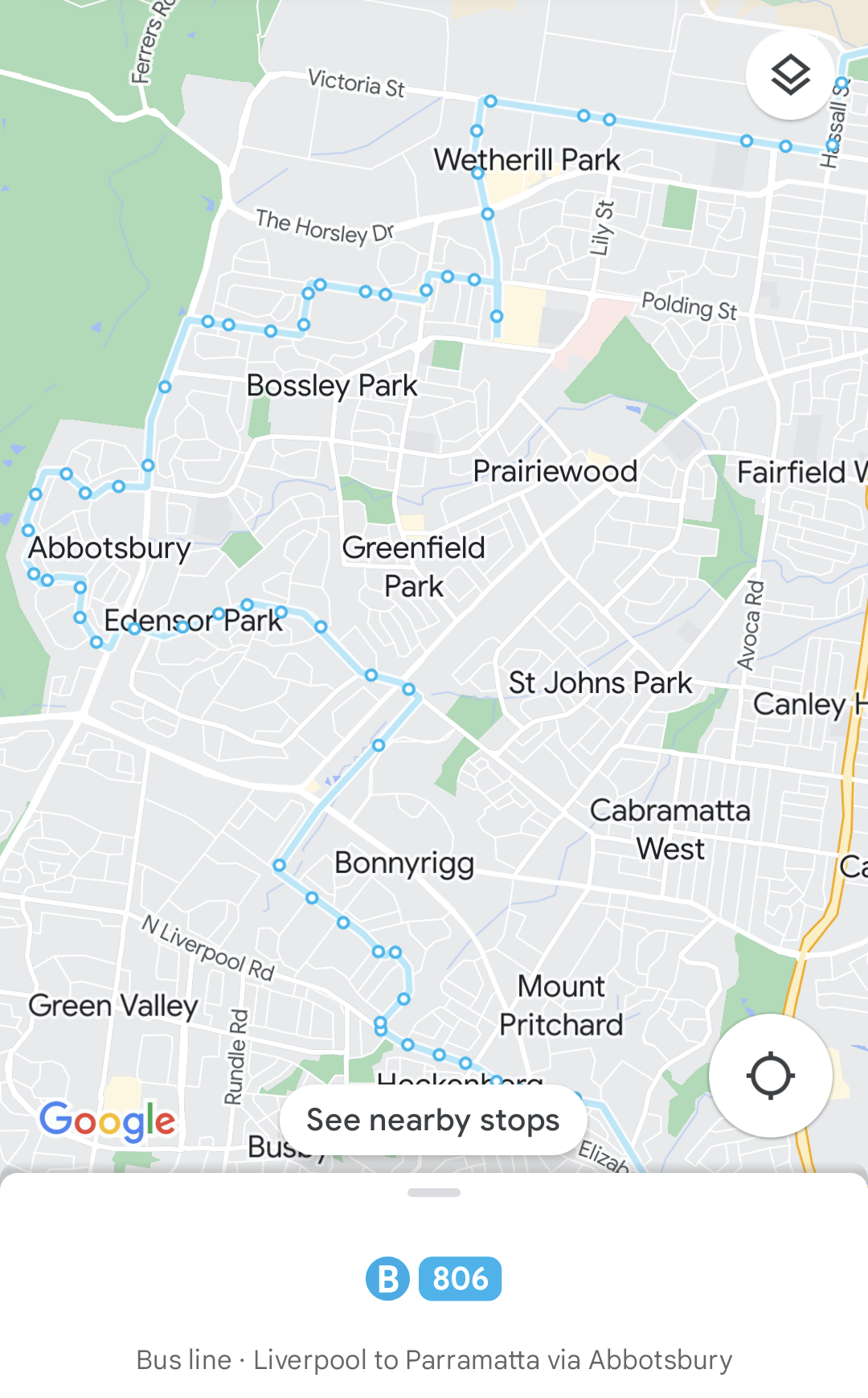
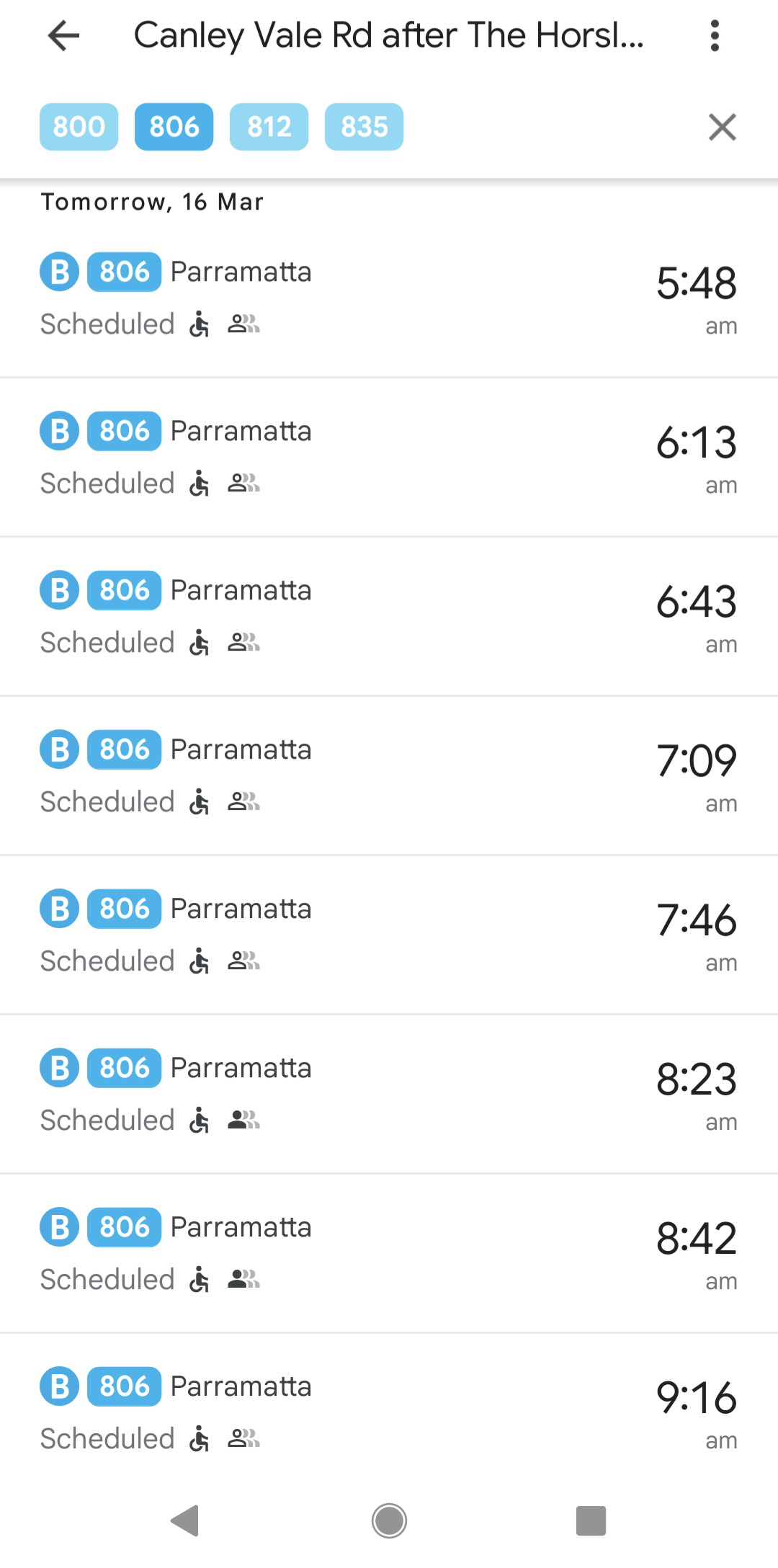
The bus is already there. It already runs. Just it’s incredibly infrequent.
Improving the timetable so it runs every 10 minutes would be enough to encourage more people to use public transport, rather than driving.
And it can be accomplished at a fraction of the cost of a new underground metro or light rail.
A mini-bus taxi service won’t do the trick. It’s less than what’s there already.
And we’re not talking bus rapid transit here. Just a regular, reliable bus service with a decent frequency.
Yes, in an ideal world, suburbs such as the ones the 806 shouldn’t exist. The fact they were built is a planning mistake.
Now that they do exist, is there a case that at least getting decent bus and cycling infrastructure should be more of a focus than it is in urbanist circles.
Sure, but typically such lines operate at a loss already. Making them more frequent would make the service significantly more costly.
So either the inhabitants of the suburb will have to pay expensive bus tickets, which they will likely not do as most of them have a car already, or other, likely poorer, city inhabitants have to subsedize this bus service in this suburb even further than they already do.
In Australian metro areas, typically outer suburbs are poorer than the inner city.
For example, the median price for a three-bedroom house in Surry Hills (around 1 kilometre from the Sydney Central Business District) is A$2.3 million. In Bossley Park (where the 806 bus runs), 36 kilometres west of the Sydney CBD, it’s $990,000.
Surry Hills is also walking distance to multiple train lines, has light rail, and multiple high frequency bus lines.
Public transport is a network. Even if I don’t live in Bossley Park, I still benefit from it having higher frequency services, because if I need to travel out there I can on the public transport network.
In Australia, public transport is funded by state governments (rather than by local councils), and tends to be operated as a metropolitan-wide network with a single system-wide ticketing system.
The other important point is that if the local bus there runs once every 30 minutes, there will be far fewer people who use it than if it runs every 10 minutes.
The great thing about public transport is that it benefits from economies of scale.
The more people that use a system, the lower the cost of that system is per passenger.
There are overhead costs in running a depot and maintaining a fleet. The more services that run, the less these cost per service (because those fleet and depot overheads are distributed across a larger number of trips).
The cost to run a bus (the driver’s salary, maintenance, fuel, etc) is the same whether there’s one person onboard, or 40. But the more people aboard each bus, the lower that cost is per passenger.
Assuming a fixed fare per passenger, the more people on board, the more of that cost is covered through the fare Box.
The cost of going from one service each half hour to three is relatively low compared to other public transport investments (such as building new metro or light rail lines).
Yet it can generate a substantial increase in the percentage of trips taken by public transport, and the overall number of passengers.
That leads to lower costs per passenger.
And more passengers on local bus routes means more passengers on their connecting train services too.
I don’t generally disagree, but I think you have a few blind spots in your argument.
First of all, poorer people that subsidize these services tend to not own houses at all, but rather rent apartments.
And secondly, sure economics of scale, but you don’t magically increase the number of riders by offering a higher frequency, at least not in the short term and especially not in areas where people already settled into a routine of using their own car. So by doubling or tripling the frequency you are effectively doubling of tripling the variable costs, without substantially increasing the income from a higher number of riders.
In general these bus lines are already cost optimized. If a bus runs every 30 minutes, that usually means a round trip takes about 50 minutes plus a bit flexibility and a short break for the driver. This way two busses and two drivers going in opposite directions can cover the whole route. Increasing the frequency immediately doubles the costs, as buses and drivers are discrete entities, but is unlikely to double the number of passengers.
I know in the US, inner city areas have tended to be where poorer people lived, and the outer suburbs is where wealthier people live.
In Australia, it tends to be the opposite. The inner city is wealthier, outer suburbs tend to be poorer.
So the median rent for a two-bedroom apartment in Surry Hills is A$820 per week.
The median rent for a three-bedroom house in Bossley Park is A$560 per week.
So it’s around $260 per week cheaper to rent a three-bedroom house in an outer suburb in Western Sydney, such as Bossley Park, than a two-bedroom apartment that’s 1km away from Sydney Town Hall.
So that social equity equation is the polar opposite in Australia, compared to the US.
In terms of the costs, running four additional buses per hour to transport people from the outer suburbs by bus pales in comparison to doing it by road.
In Sydney, the WestConnex road tunnel cost A$16.8 billion, mostly to transport people from outer Western Sydney to the CBD and the airport: https://roadsonline.com.au/third-stage-of-16-8-billion-westconnex-project-now-open/
In comparison, 10-minute bus services are a drop in the ocean.
One more thing on costs and social equity.
In Glebe, an inner-city neighbourhood 3 kilometres from the centre of Sydney, the local 433 bus runs at a peak hour frequency of around one service every 10 minutes:
:
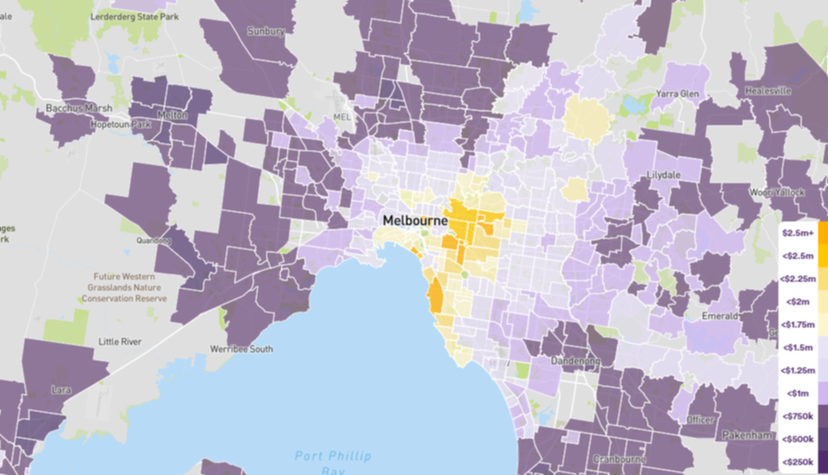
Similar heatmap for Sydney. Again, highest prices in the inner city and a cluster of suburbs immediately to the east of the city, on the north side of the harbour, and the inner west. Note also that the further you go west, the more purple the suburbs tend to be:
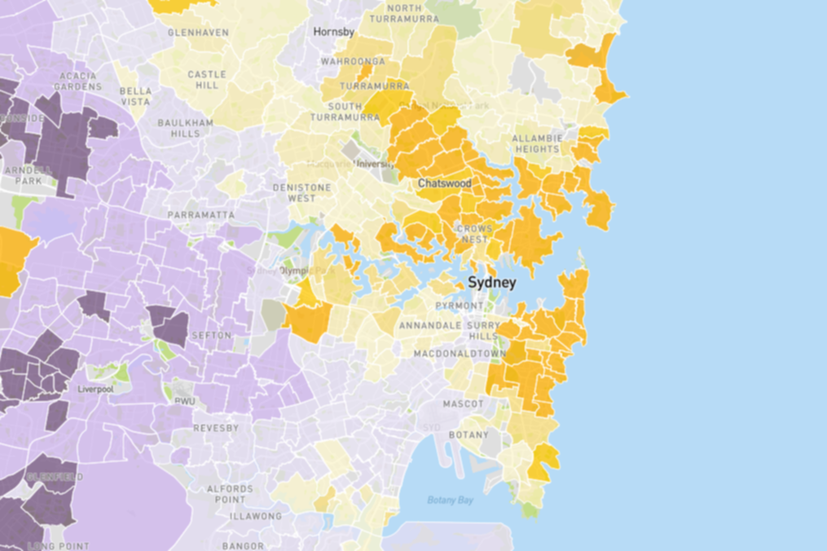
There’s also a well-known meme about socioeconomics in Sydney known as the “Red Rooster line”.
Basically, the fast food chain Red Rooster tends to only operate its stores in working class outer suburbs.
By plotting a line between the stores that are closest to the Sydney CBD, you get a good approximation of where the boundary line is between wealthier the inner suburbs and the poorer outer suburbs of Western Sydney.
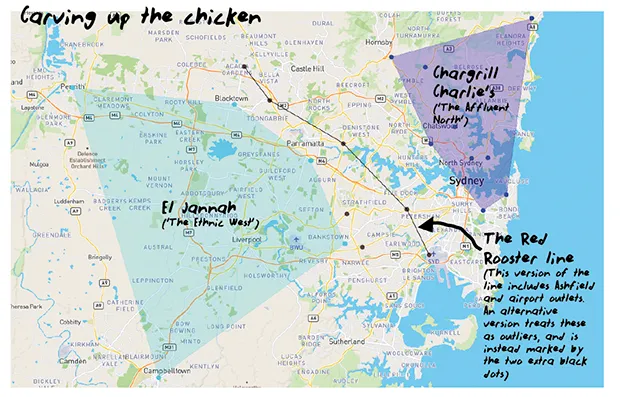
If you’re interested, here’s some analysis of the Red Rooster line from the University of NSW: https://newsroom.unsw.edu.au/news/social-affairs/imaginary-line-exposing-real-sydney-divide
Here’s a good YouTube explainer of it: https://www.youtube.com/watch?v=EAPSSQALBXY
From the Australian Financial Review:
"Waterfront locations and coveted school zones dominate the country’s most expensive postcodes, new Domain data shows.
"All the postcodes in the top-20 list were in Sydney, led by the eastern suburbs, the northern beaches and the north shore.
“Six of the postcodes in the top 20 have a median house price higher than $5 million, and 12 have a median price above $4 million.”
So yes, Australia hasn’t seen the same hollowing out of property prices in the inner-city and inner suburbs of our metropolitan areas as the US. Very much the opposite in fact.
And those wealthy folks in the inner suburbs have a lot of well-resourced NIMBY groups that fight what they see as “overdevelopment”, and who get their leafy inner suburbs heritage protected, pushing more development to the outer suburban fringe. This is a serious ongoing issue: https://www.smh.com.au/national/nsw/overdevelopment-bludgeons-us-out-of-our-homes-say-residents-20230208-p5ciwi.html
In principle, I completely agree that we need more density near existing rail lines, in the inner city, and the inner suburbs.
I absolutely agree that all new development should be within walking distance of train and trams, in medium- or higher-density mixed-use higher density communities.
But.
That leaves a whole bunch of outer suburbs that were built in the '60s, '70s, '80s, '90s, and more recently that are heavily car dependent.
In Australia at least, these outer suburbs tend to overwhelmingly be working class.
And in many of them, the only accessible mode of transport is the bus.
At least in the short- and medium-term, the most cost-effective way of providing transport to these areas, and improving social equity, is by improving bus services.
@ajsadauskas @poVoq
Busses can be useful and they can provide top-notch public transportation. To be effective and on time, they need designated lanes or streets that don’t allow privately owned cars. May as well put streetcars in. They are quieter and cleaner.@No_One @ajsadauskas @poVoq Almere, The Netherlands was designed with dedicated bus rights of way for 90% of their route. The reason trams weren’t chosen was the expected population (trams carry 2x as many people) and the infrastructure cost that it adds. A concrete base, asphalt topped bus track is well under half the price due to the high cost of electrification.
@No_One @ajsadauskas @poVoq I would love them to upgrade to trams though then the right of way could be narrower and we could have grassed in tracks.
@No_One @ajsadauskas @poVoq I really *do* love my trams more than my buses, even the L2 and L3
But surely there are circumstances where 5 bus services for the price of 1 tram service (I am picking a number out of thin air, correct me please) is worthwhile
And a combination of bus-only road closures and sensible route selections can make all the difference to reliability — you don’t need a BRT everywhere
@ckent @ajsadauskas @poVoq
Honolulu is an example of a city that had really good bus service. I haven’t checked recently but last I knew their service was great.@No_One @ajsadauskas @poVoq TFW you really want to go and look, meet and enjoy through the eyes of locals, observe and learn …
and yet the indigenous population are begging you not to visit
Ppl who pay $5M for a house or apartment do hardly use public transport at all. The reason public transport in the center is better than in the suburbs is that everything meets in the center. Business, tourists, doctors, entertainment etc. So it effects everyone who is using public transport. But the suburbs only effect those living in that suburb. It has nothing to do with rich ppl living in the center. |1
Also not everyone in the suburbs owns a car or is even able to drive one. So a decent public transport is required in the suburbs too.
And from own observation: the more frequent a bus or train is offered the fuller they are. If a bus is only coming by once every hour or even less ppl will either not move there or have a car to get to work. Not because they want to but because they don’t feel like they have a choice. |2
@wolkenblume @ajsadauskas @poVoq
This. Induced demand cuts both ways. provide high quality, frequent public transport and people will shift their behaviour accordingly.When visiting Perth I dont hire a car. I ride the bus and the train together. Its well integrated, ease to use and has well planned timetables for excellent connections.
In Sydney, if I cant get there by train, I drive, because the buses are a tangled, confusing, poorly integrated and unreliable mess.
I guess one of the main problems is that in some cases suburbia doesn’t have the population density for bus services to be cost affective (buses should be subsidised but cost is still a factor). Even if everyone in suburbia stopped driving this would still be a problem.
One solution is to have some sort of local transport hub where there are more frequent bus services as well as facilities to store bikes/scooters. This would probably only work well if you have cycle path infrastructure linking suburbia to these transport hubs. There will probably still need to be buses going to suburbia for people who can’t bike/scooter to the transport hubs.
Population density isn’t the only variable that determines the number of passengers. The other two critical variables are service levels (the quality of public transport services and how frequently they run), and modal share (the percentage of trips taken by public transport.
High population density doesn’t automatically guarantee either good service levels, or high ridership (although it can help with both of those things).
There are high-density cities with low ridership and low modal shares, and very low density villages (think Switzerland) that have high public transport modal shares and relatively high levels of public transport ridership.
There are real world examples where increasing service frequency leads to a huge growth in public transport use. It’s the same area, with the same population density, upgrading to higher service frequencies has led to higher public transport modal share, and higher ridership. Here’s an example: https://www.busnews.com.au/industry-news/0907/patronage-on-new-smartbus-route-highest-on-record
In many suburbs, the modal share for cars is well over 90% because there’s no viable alternative.
If the public transport option is one or two buses every hour, then of course it’s not going to be a viable option for many people.
Increase the frequency to one bus every 10 minutes, and it becomes a more viable option for more people, and suddenly it becomes a much better option for more people. This leads to a higher percentage of trips being made by public transport.
These are good points. In general I think it is good to increase bus frequency everywhere.
However I do still think that we should prioritise adding bus services to try and maximize usage (and stop as many car journeys as possible). Population density is definitely a factor here but (as you pointed out) so are other things like car usage in the area.
@uthredii @ajsadauskas Car Dependency ≠ Transport Choice
It’s not really a war on cars. It’s a war on having no choices but the cars. Even the cars have a nicer time when the lanes are replaced with bikes and trams. Ask any Dutch car driver.
Fine, ask any TV commercial for a car. Do you see other cars in it? Well, DO YOU?
Oh, don’t get me wrong, I’m all for higher density and transport-oriented developments.
But at the same time, there are still a lot of suburbs out there, and until we can retrofit them all, we should aim to get at least some decent public transport out there.
@ajsadauskas @uthredii ^^^ this post
… should be a dull-ass statement of the bleeding obvious
pity it ain’t
@ajsadauskas It’s always cheaper to work on with what you have and improve upon it, rather than getting everything from 0. If you have some unused rails though, it’s better for you to use these instead, or in conjunction with the bus network (i.e. making the bus network serving areas where the line is not going).
My city has an extensive tram network and quite a lot of train lines serving former factories, now abandoned. The current mayor has plans for revitalizing these, electrifying them, and starting a metropolitan train service on it (sort of a RER or S-Bahn-like service), yet things are moving way too slow, and I’m afraid he’ll not finish the whole project until the next elections.










